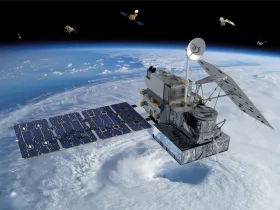The Coronavirus Resource Center at Johns Hopkins University in Baltimore, Md. is tracking the number and spread of cases of COVID-19 in the U.S. Among the many doctors and public health experts collaborating to make use of the Resource Center’s data is climate scientist Ben Zaitchik.
Zaitchik's COVID-19 focused research builds on his NASA-funded work studying the spread of infectious diseases and possible connections to weather and climate changes. His work was recently featured in the NASA Earth Observatory feature, Could COVID-19 Have Seasons? Searching for Signals in Earth Data.
While working from home, like so many of his fellow scientists, Zaitchik answered a few questions about what it's like to be a climate scientist working with doctors and epidemiologists, and the unsettling shift to tracking a disease right outside his front door.
Q: Your initial NASA grant was on applying data, temperature, precipitation and other weather and climate data on a completely different set of diseases, not COVID-19, right?
Yes, we were studying enteric infectious diseases, the bugs you get in the guts. These are diseases that can cause diarrhea, like cholera and rotavirus. Diarrhea is unpleasant for anyone, but it's a huge issue in developing countries and is one of the leading causes of death for kids worldwide. We gave priority to the specific enteric diseases that have vaccines because that means we have a great tool to stop them. Our job is to figure out where the risk is so that the vaccines can be deployed effectively.
The crazy thing about these diseases is that it's an important health issue, but it's often not diagnosed as a specific disease. Instead it's noted on health records as "treated patient with fluids," and you have no idea which bug It was. So, the team takes what data we do have, some of it is very detailed and some is quite general, and then combines it with environmental parameters. Many of these gastrointestinal infectious diseases are sensitive to environmental conditions.
Q: What NASA assets are you using and how did you pivot to studying COVID-19?
There's quite a few NASA missions that collect data on temperature and precipitation and those are, of course, potential hydroclimatic factors that can influence the spread of some diseases. We're looking at GPM [the Global Precipitation Measurement mission, jointly run by the Japan Aerospace Exploration Agency and NASA]. We're looking at MODIS and other sensors that derive temperature. [MODIS is the MODerate Resolution Imaging Spectroradiometer aboard NASA's Terra and Aqua satellites]. We're looking at SMAP for soil moisture [SMAP is NASA's Soil Moisture Active Passive Mission]. We're also using meteorological data from MERRA-2 [NASA's Modern-Era Retrospective analysis for Research and Applications, Version 2].
It's uniquely NASA because those datasets are in play and so we're tying Earth observations to cohort studies to tease out the part about environmental sensitivities. We were working through a previous list of diseases, one at a time. We had just finished rotavirus and shigella and for the first time we were able to add in environmental data into the disease information. Then corona started.
So, we have this big database of all we've collected and we're connecting our data with the Hopkins COVID-19 dashboard. There's a lot of speculation that heat or humidity may affect COVID-19. There's some validity to that idea because other respiratory diseases show an effect. Influenza is quite clearly sensitive to the environment. Cases go down in the summer, and it's not just because people are outside a lot. SARS also showed seasonality, but MERS didn’t seem to. There's just so much we don't know.
[MERS is short for Middle East Respiratory Syndrome, also spread by a coronavirus, as is Severe Acute Respiratory Syndrome, or SARS.]
Q: That's the big question right, will COVID-19 cases go down in the summer?
We don't think that summertime is going to stop this thing. Frankly, there are so many factors in play right now it’s extremely difficult to tease environmental factors out of the data in a definitive way. It is important to note that often takes years to even get in the room with policy makers, and right now everything is so sped up. Someone comes out with a study and it's on the front page of the New York Times. So, we need to keep studying and get information out in a responsible way, in a way that is peer reviewed and shows context. Other factors like the virus burning through populations and social distancing have a much, much greater effect right now.
Q: Speaking of social distancing, are you working from home or the office?
Oh, I'm at home. We have a 2-year-old and a 6-year-old, and my wife is a medical doctor, a real doctor, not like me (laughs). She's a Johns Hopkins doctor mostly doing telemedicine from home. I had worked at NASA Goddard and then at the State Department and soon after she got a position at Hopkins I came there as well.
Johns Hopkins isn’t a big center for climate work, so when I started, I was the only self-described applied climate scientist here. But what Hopkins does have is a high-rise building of public health people, and so I showed up and people were knocking on my door literally asking questions like, "I'm thinking about malaria, how do I get information about temperature?"
It's odd because some of this is really easy for us Earth scientists and then I quickly realized that I needed to give context, it's not just how to access the data, but what that data means. It's been a lot of fun for me to get to learn all about the health side of…
[In the middle of this answer Zaitchik is interrupted by his 6-year-old.]
Sorry about that, there was an issue logging into virtual school.
Q: How is working from home going? I imagine it must be odd because most of the diseases you've studied don't happen in Maryland, but in far-off places.
Well, there's not a lot of sleep. But we're lucky that we can both work from home. I can just stay up late into the middle of the night and do my work. There's this odd feeling that the world has changed but I’m here just doing what I always do.
I'll get engrossed in the research and the data, like I have on other diseases, and then I'll look at the social distancing program data and I'll realize that I'm doing this work here at home, with my 2-year-old here with me and I'm like 'Oh social distancing! It's happening right now, right here.'
Q: What's your next step for this project?
We're continuing the work, getting the data. Like many people in Earth sciences, a lot of us got into this for the applications reasons. We're really interested in seeing how Earth systems affect us and how we affect it.
- More information on NASA's efforts related to the COVID-19 pandemic is available at the website, NASA Response to Coronavirus.






